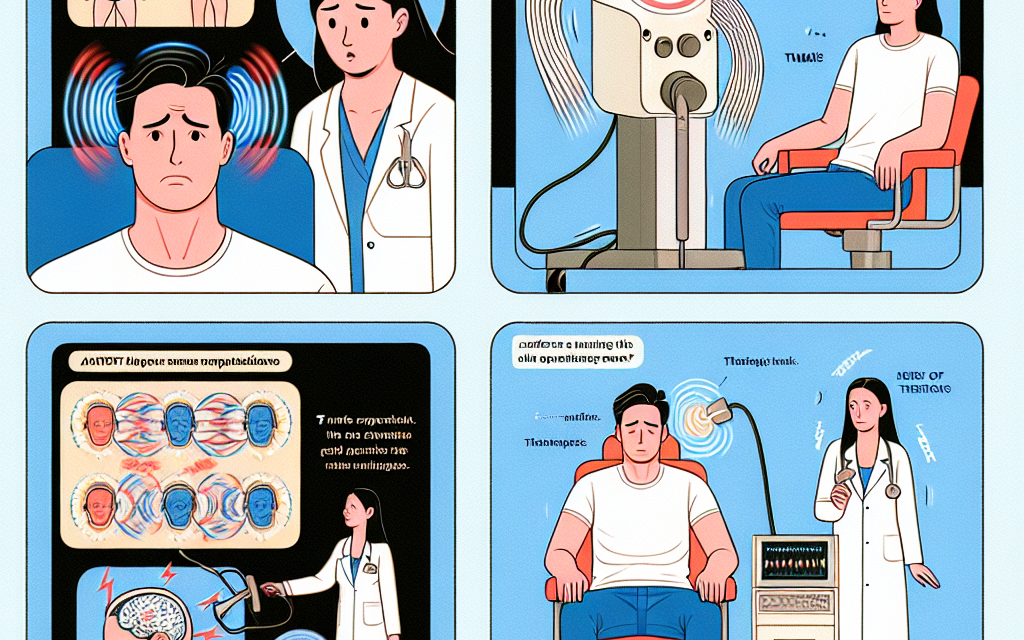Exploring the Effectiveness of TMS for Anxiety: A Complete Guide to Its Advantages
Transcranial Magnetic Stimulation (TMS) has emerged as a promising treatment for various mental health conditions, particularly depression. However, its effectiveness in treating anxiety disorders is gaining attention. This article delves into the advantages of TMS for anxiety, exploring its mechanisms, benefits, and real-world applications.
Understanding TMS: Mechanism and Application
Transcranial Magnetic Stimulation (TMS) is a non-invasive procedure that uses magnetic fields to stimulate nerve cells in the brain. It is primarily used to treat depression, but research is increasingly supporting its use for anxiety disorders. TMS works by targeting specific areas of the brain associated with mood regulation and anxiety response.
The procedure involves placing a magnetic coil on the scalp, which generates magnetic pulses that penetrate the skull and stimulate neurons. This stimulation can enhance neuronal activity in areas of the brain that are underactive in individuals with anxiety disorders, such as the prefrontal cortex and the anterior cingulate cortex.
One of the key advantages of TMS is that it is a non-invasive treatment option, meaning it does not require surgery or anesthesia. Sessions typically last about 20 to 40 minutes, and patients can resume their normal activities immediately afterward. This makes TMS a convenient option for those who may be hesitant to pursue more invasive treatments.
The Science Behind TMS and Anxiety
Research into the effectiveness of TMS for anxiety is still evolving, but several studies have shown promising results. A meta-analysis published in the journal “Brain Stimulation” found that TMS significantly reduced anxiety symptoms in patients with various anxiety disorders, including generalized anxiety disorder (GAD), social anxiety disorder (SAD), and post-traumatic stress disorder (PTSD).
One study conducted by the University of California, Los Angeles (UCLA) found that patients with GAD who underwent TMS experienced a significant reduction in anxiety symptoms after just a few sessions. The researchers noted that TMS not only reduced anxiety but also improved overall mood and quality of life.
Another study published in “The Journal of Neuropsychiatry and Clinical Neurosciences” reported that TMS was effective in reducing symptoms of PTSD in veterans. The study highlighted that TMS could help alleviate intrusive thoughts and hyperarousal symptoms, which are common in PTSD patients.
These findings suggest that TMS may offer a viable alternative for individuals who have not responded well to traditional anxiety treatments, such as psychotherapy or medication. The ability of TMS to target specific brain regions involved in anxiety regulation is a significant factor in its effectiveness.
Advantages of TMS for Anxiety Treatment
TMS offers several advantages over traditional anxiety treatments, making it an appealing option for many patients. Here are some of the key benefits:
- Non-Invasive: Unlike surgical interventions, TMS is non-invasive and does not require anesthesia, making it a safer option for many patients.
- Minimal Side Effects: TMS has fewer side effects compared to medications, which can often cause weight gain, sexual dysfunction, or sedation.
- Quick Treatment Sessions: Each TMS session lasts only 20 to 40 minutes, allowing patients to fit treatment into their busy schedules.
- Long-Lasting Effects: Many patients experience sustained relief from anxiety symptoms even after completing their TMS treatment course.
- Personalized Treatment: TMS can be tailored to target specific brain regions based on individual needs, enhancing its effectiveness.
These advantages make TMS an attractive option for individuals seeking relief from anxiety disorders, particularly those who have not found success with other treatments.
Case Studies: Real-World Applications of TMS for Anxiety
To better understand the effectiveness of TMS for anxiety, it is helpful to examine real-world case studies. These examples illustrate how TMS has been successfully implemented in clinical settings.
One notable case involved a 35-year-old woman diagnosed with severe generalized anxiety disorder. After years of therapy and medication with little improvement, she was referred for TMS treatment. Over the course of six weeks, she underwent daily TMS sessions targeting the prefrontal cortex. By the end of her treatment, she reported a significant reduction in anxiety symptoms and an improved ability to manage daily stressors.
Another case study focused on a 50-year-old veteran suffering from PTSD. Traditional treatments had failed to provide relief, and he was struggling with flashbacks and hyperarousal. After completing a series of TMS sessions, he experienced a marked decrease in intrusive thoughts and improved sleep quality. His overall quality of life improved significantly, allowing him to engage more fully in social activities.
These case studies highlight the potential of TMS to provide relief for individuals who have not responded to conventional treatments. They also underscore the importance of personalized treatment plans that consider the unique needs of each patient.
Considerations and Limitations of TMS for Anxiety
While TMS offers many advantages, it is essential to consider its limitations and potential challenges. Understanding these factors can help patients make informed decisions about their treatment options.
- Not a First-Line Treatment: TMS is generally considered a second-line treatment for anxiety disorders, meaning it is typically recommended after other treatments have failed.
- Cost and Accessibility: TMS can be expensive, and not all insurance plans cover the treatment. Additionally, access to TMS clinics may be limited in some areas.
- Variable Response Rates: Not all patients respond to TMS, and the effectiveness can vary based on individual factors such as the severity of anxiety and co-occurring conditions.
- Time Commitment: While each session is relatively short, the total number of sessions required can be significant, often ranging from 20 to 30 sessions over several weeks.
- Potential Side Effects: Although TMS is generally well-tolerated, some patients may experience mild side effects such as headache, scalp discomfort, or transient mood changes.
These considerations highlight the importance of a comprehensive evaluation by a mental health professional before pursuing TMS as a treatment option. It is crucial for patients to weigh the potential benefits against the limitations and to explore all available treatment options.
Conclusion: The Future of TMS in Anxiety Treatment
Transcranial Magnetic Stimulation represents a significant advancement in the treatment of anxiety disorders. Its non-invasive nature, minimal side effects, and ability to provide lasting relief make it an appealing option for many patients. As research continues to evolve, the understanding of TMS’s effectiveness for anxiety will likely expand, leading to more refined treatment protocols and improved patient outcomes.
For individuals struggling with anxiety, TMS offers hope, particularly for those who have not found success with traditional treatments. By targeting specific brain regions involved in anxiety regulation, TMS has the potential to transform the lives of many patients, providing them with the tools they need to manage their symptoms effectively.
In summary, TMS is a promising treatment option for anxiety disorders, with numerous advantages that set it apart from traditional therapies. As more studies validate its effectiveness, TMS may become a standard part of the treatment landscape for anxiety, offering relief to those in need.





